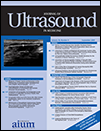Use of Sonography in Thoracic Outlet Syndrome Due to a Dystonic Pectoralis Minor
Abstract
Objective. For patients with thoracic outlet syndrome (TOS), it is important to determine the location of the neurovascular compression to achieve effective intervention. Methods. The diagnostic workup for a 39-year-old man with TOS included a selective anesthetic block of the pectoralis minor muscle and duplex sonography before and after the block. Results. The subclavian artery peak systolic flow velocity decreased after the block from 208 to 63 cm/s when the arm was in the abduction and external rotation position, indicating a reduction in the severity of focal arterial compression. Also, the arterial diameter increased by 10% after the block (from 0.80 to 0.88 cm). His level of discomfort was reduced from 6 to 2 on a scale of 1 to 10 (66%). Conclusions. The pectoralis minor block resulted in an improvement in subclavian artery blood flow and symptoms and confirmed the diagnosis of pectoralis minor TOS. This suggests that selective anesthetic muscle blocks and duplex sonographic studies may be useful before chemodenervation and surgery.




